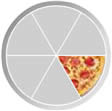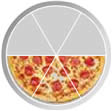Lesson 17:
Looking at division of fractions in a visual way.
I think this is an excellent way to introduce fractions for children using pictures and models so that they can visualize and see what is actually happening with the different parts; this will enhance their conceptual understanding of math. I wish I had had this exposure when I was young. We had an in-depth discussion about why ¾ divided by ½ is still ½? Another discussions was that it should be 1 1/2. Thinking about it would 3/4 divided by 1/2 be 1.5 and not half. It is important to visualize this in order to understand.
| Does | 1 | ÷ | 1 | really equal 3 ? |
| 2 | 6 |
You can change a question like "What is 20 divided by 5?" into "How many 5s fit into 20?"
In the same way our fraction question can become:
Now look at the pizzas below ... how many "1/6th slices" fit into a "1/2 slice"?
In the same way our fraction question can become:
| 1 | ÷ | 1 | How many | 1 | in | 1 | ? | |
| 2 | 6 | 6 | 2 |
| How many |  | in |  | ? | Answer: 3 |
| So now you can see that | 1 | ÷ | 1 | = 3 | really does makes sense! | ||
| 2 | 6 |
The above example, retrieved on August 29, 2011 from http://www.mathsisfun.com/fractions_division.html.
Another example was the following question: What is 1/5 divided by ½? To do this we divided the model into equal 10 pieces. Thus, 2/10 divided by 5/10 (because we know that half of ten is 5). The answer is 2/5.
Or
2. Two Fifths divided by One tenths = Four tenths divided by One tenth = 4 divided by One = 4.
Lesson 18:
We were looking at a homework example for a primary three student. Question: Valentino has ½ liter of orange juice but he needs 5/7 liter of orange juice.
Well, in this case we used a model. We know that 7/7 is a whole and Valentino has half In order to divide this easily we cut the model into 14 equal parts.
Therefore, 10/14 minus 7/14 = 3/14.
It was interesting to learn that this type of question (when used to assess students) would be considered at application level for a primary three student but for a primary five student it is at comprehension level. The primary 5 student would have come across this question more frequently in math class. Bloom’s Taxonomy provides an important framework for teachers to use to assess students’ cognition. In primary school the focus is on the following three levels of Bloom’s Taxonomy:
1. Knowledge level
2. Comprehension level
3. Application level
We discussed the significance of giving students time. If you wait long enough you will find interesting ways that students can come up with to solve the problem. Teachers should not be too eager to say, “Yes, that’s right.” Instead say, “Are you sure?” Maybe there are other ways to arrive at the solution…I agree! Students learn right or wrong from external stimulus. It is important not to give artificial signals (for example, body language, answers, tone of voice) for students to depend on. Try to be as natural in all situations. This made me reflect on the impact on a student’s self-confidence when a teachers gives feedback to one student with a comment of, “excellent” and another student gets a, “good”. How does the student feel who only received the comment, “good”?
We repeated the use of numbers and added that numbers can be used to represent proportion:
1. Ordinal numbers
2. Cardinal numbers
3. Measurement numbers
4. Nominal
5. Represent proportion (for example, 3/4 of a class)
Lesson 19:
Area
In this lesson we drew different sizes of squares on a dotted paper. It was interesting to see that we could come up with 8 different squares and discussed the size of the squares. How do we know that one is bigger than the other? Well, we counted the squares inside. It is important to start with non-standard units (how many squares per unit) instead of actual measuring of the square’s cm in the lower primary levels when children are comparing sizes.
Lesson 20:
Area of the polygons related to dots.
Polygon means a closed figure. We learnt that given a polygon on a grid of equal-distance points George Pick provides a simple formula for calculating the area of the polygon. The formula is A= i = b divide by 2 – 1 (retrieved August 29, 2011 from http://www.cut-the-knot.org/ctk/Pick.shtml).
Thank you Dr. Yeap for yet a very interesting and engaging lesson! I have more confidence with math.

No comments:
Post a Comment